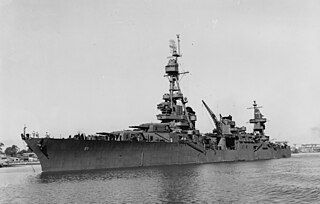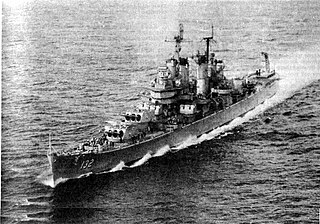USS Northampton has been the name of three ships in the United States Navy:
- USS Northampton (SP-670), a wooden motor boat acquired in 1917 and returned to its owner in 1918.
- USS Northampton (CA-26), lead ship of the Northampton-class cruisers, commissioned in 1930 and was sunk at the Battle of Tassafaronga in 1942.
- USS Northampton (CLC-1) was a command ship that was originally laid down as heavy cruiser CA-125 in 1944. Work on her was suspended the next year prior to launching, then recommenced in 1948 when it was decided to make her a command ship. She was launched in 1951, commissioned in 1953 and served until 1970.
The first USS Northampton (SP-670), was a wooden motor boat acquired by the United States Navy for patrol duty during World War I.

USS Northampton (CL/CA-26) was the lead Northampton-class cruiser in service with the United States Navy. She was commissioned in 1930, originally classified a light cruiser because of her thin armor but later reclassified a heavy cruiser because of her 8-inch guns. During World War II she served in the Pacific and was sunk by Japanese torpedoes during the Battle of Tassafaronga on 30 November 1942. She was named after the city of Northampton, Massachusetts, the home of former President Calvin Coolidge.

The third USS Northampton (CLC-1) was a US Navy command light cruiser. She was laid down as an Oregon City-class heavy cruiser (CA–125), on 31 August 1944 by the Fore River Yard, Bethlehem Steel Corp., Quincy, Massachusetts. Work suspended between 11 August 1945 and 1 July 1948; she was launched as CLC–1, on 27 January 1951; sponsored by Mrs. Edmond J. Lampron; and commissioned as CLC–1, on 7 March 1953, Captain William D. Irvin in command.
Other uses
- During World War II, the U.S. Naval Reserve Midshipmen's School at Smith College in Northampton, Massachusetts, which trained officers of the Women's Reserve of the U.S. Naval Reserve (WAVES), was nicknamed "USS Northampton".

World War II, also known as the Second World War, was a global war that lasted from 1939 to 1945. The vast majority of the world's countries—including all the great powers—eventually formed two opposing military alliances: the Allies and the Axis. A state of total war emerged, directly involving more than 100 million people from over 30 countries. The major participants threw their entire economic, industrial, and scientific capabilities behind the war effort, blurring the distinction between civilian and military resources. World War II was the deadliest conflict in human history, marked by 50 to 85 million fatalities, most of whom were civilians in the Soviet Union and China. It included massacres, the genocide of the Holocaust, strategic bombing, premeditated death from starvation and disease, and the only use of nuclear weapons in war.

Smith College is a private, independent women's liberal arts college with coed graduate and certificate programs in Northampton, Massachusetts. It is the largest member of the Seven Sisters. In its 2018 edition, U.S. News & World Report ranked it tied for 11th among the best National Liberal Arts Colleges. Smith is also a member of the Five Colleges Consortium, which allows its students to attend classes at four other Pioneer Valley institutions: Mount Holyoke College, Amherst College, Hampshire College, and the University of Massachusetts Amherst.

The city of Northampton is the county seat of Hampshire County, Massachusetts, United States. As of the 2010 census, the population of Northampton was 28,549.
| This article includes a list of ships with the same or similar names. If an internal link for a specific ship led you here, you may wish to change the link to point directly to the intended ship article, if one exists. |

















